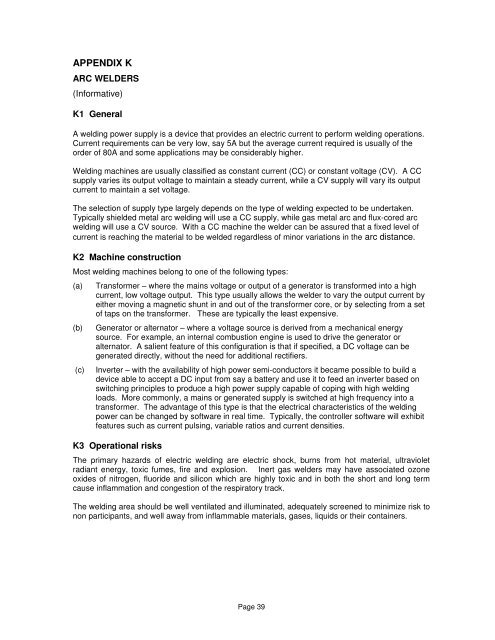In-service safety inspection and testing of electrical equipment
In-service safety inspection and testing of electrical equipment
In-service safety inspection and testing of electrical equipment
Create successful ePaper yourself
Turn your PDF publications into a flip-book with our unique Google optimized e-Paper software.
APPENDIX KARC WELDERS(<strong>In</strong>formative)K1 GeneralA welding power supply is a device that provides an electric current to perform welding operations.Current requirements can be very low, say 5A but the average current required is usually <strong>of</strong> theorder <strong>of</strong> 80A <strong>and</strong> some applications may be considerably higher.Welding machines are usually classified as constant current (CC) or constant voltage (CV). A CCsupply varies its output voltage to maintain a steady current, while a CV supply will vary its outputcurrent to maintain a set voltage.The selection <strong>of</strong> supply type largely depends on the type <strong>of</strong> welding expected to be undertaken.Typically shielded metal arc welding will use a CC supply, while gas metal arc <strong>and</strong> flux-cored arcwelding will use a CV source. With a CC machine the welder can be assured that a fixed level <strong>of</strong>current is reaching the material to be welded regardless <strong>of</strong> minor variations in the arc distance.K2 Machine constructionMost welding machines belong to one <strong>of</strong> the following types:(a)(b)(c)Transformer – where the mains voltage or output <strong>of</strong> a generator is transformed into a highcurrent, low voltage output. This type usually allows the welder to vary the output current byeither moving a magnetic shunt in <strong>and</strong> out <strong>of</strong> the transformer core, or by selecting from a set<strong>of</strong> taps on the transformer. These are typically the least expensive.Generator or alternator – where a voltage source is derived from a mechanical energysource. For example, an internal combustion engine is used to drive the generator oralternator. A salient feature <strong>of</strong> this configuration is that if specified, a DC voltage can begenerated directly, without the need for additional rectifiers.<strong>In</strong>verter – with the availability <strong>of</strong> high power semi-conductors it became possible to build adevice able to accept a DC input from say a battery <strong>and</strong> use it to feed an inverter based onswitching principles to produce a high power supply capable <strong>of</strong> coping with high weldingloads. More commonly, a mains or generated supply is switched at high frequency into atransformer. The advantage <strong>of</strong> this type is that the <strong>electrical</strong> characteristics <strong>of</strong> the weldingpower can be changed by s<strong>of</strong>tware in real time. Typically, the controller s<strong>of</strong>tware will exhibitfeatures such as current pulsing, variable ratios <strong>and</strong> current densities.K3 Operational risksThe primary hazards <strong>of</strong> electric welding are electric shock, burns from hot material, ultravioletradiant energy, toxic fumes, fire <strong>and</strong> explosion. <strong>In</strong>ert gas welders may have associated ozoneoxides <strong>of</strong> nitrogen, fluoride <strong>and</strong> silicon which are highly toxic <strong>and</strong> in both the short <strong>and</strong> long termcause inflammation <strong>and</strong> congestion <strong>of</strong> the respiratory track.The welding area should be well ventilated <strong>and</strong> illuminated, adequately screened to minimize risk tonon participants, <strong>and</strong> well away from inflammable materials, gases, liquids or their containers.Page 39
















